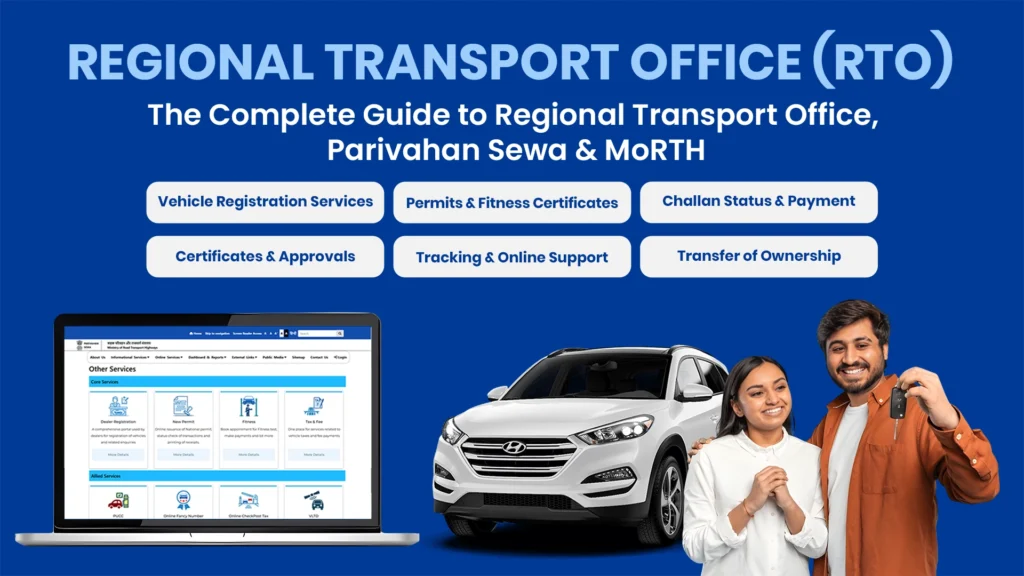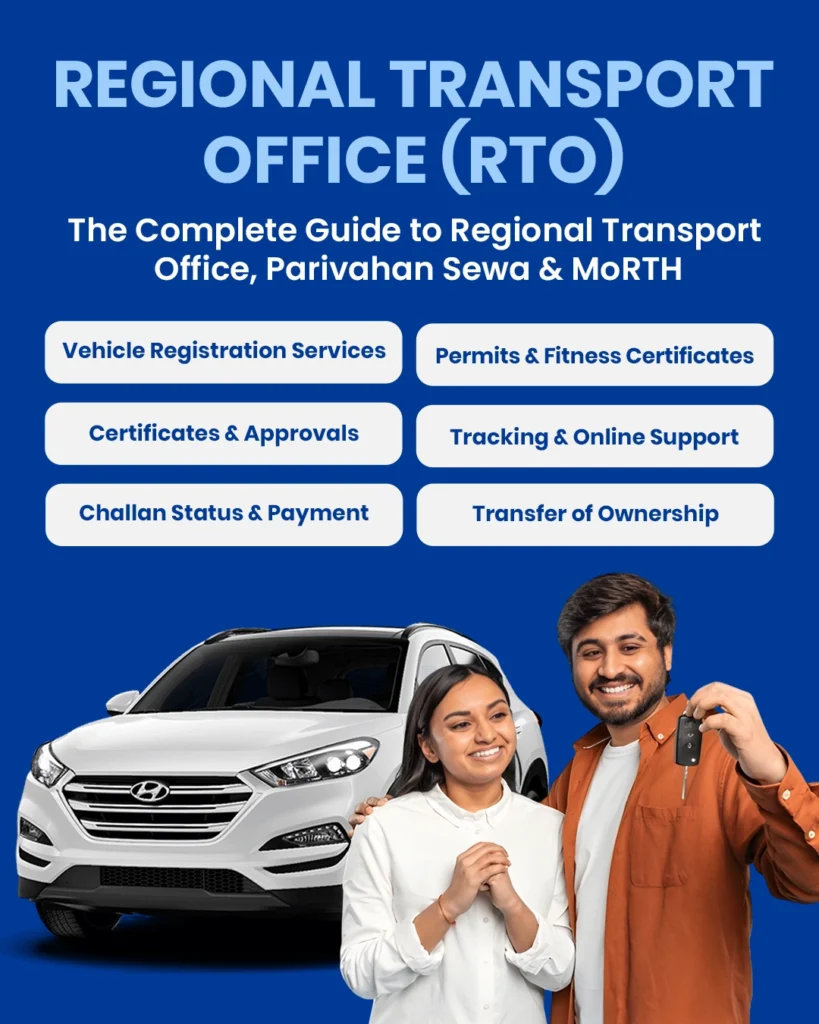
It was a rainy evening in Pune. Traffic was slow, horns blared, and the thought of standing in a long RTO queue the next morning made Priya sigh in frustration. Her driving licence renewal was overdue, and she dreaded the paperwork, forms, and endless waiting that came with a visit to the Regional Transport Office (RTO).
Out of curiosity, she opened her laptop and searched for “licence renewal online.” That’s when she discovered the Parivahan Sewa portal the official government platform under the Ministry of Road Transport and Highways (MoRTH). Within minutes, Priya created her account, uploaded her documents, paid the renewal fee, and booked an appointment slot all without leaving home.
A few clicks later, she received a confirmation message. What once felt like a full-day struggle at a crowded office had turned into a 10-minute online task. Priya leaned back, smiling as the rain tapped against her window. For the first time, she realized that government services in India were truly evolving becoming faster, more transparent, and designed around the citizen’s convenience.
That small moment of relief wasn’t just about skipping a queue; it symbolized a much bigger transformation how the system, with the support of MoRTH and Parivahan Sewa, was finally adapting to modern India’s digital era.

What is an RTO?
RTO stands for Regional Transport Office the government department that manages vehicle registration, issues driving licences, collects road taxes, enforces transport laws, and promotes road safety.
Every state and union territory in India has multiple RTOs operating under the framework of the Ministry of Road Transport and Highways (MoRTH) and the State Transport Department.
It maintains official records of all registered vehicles and licensed drivers. It also issues fitness certificates, permits for commercial transport, and enforces compliance with the Motor Vehicles Act.
In simple terms, the RTO is your go-to authority for everything related to vehicles, driving, and road safety.
Why the RTO Matters to You (and Your Daily Commute)
Whether you’re a car owner, bike rider, or commercial driver, the RTO impacts your daily life in several ways:
Simply put, without the RTO, the road transport system in India wouldn’t function smoothly.
The Role of the Ministry of Road Transport and Highways (MoRTH)
The Ministry of Road Transport and Highways (MoRTH) is the central authority responsible for setting national transport policies, safety standards, and digital initiatives.
While MoRTH frames the rules, state RTOs implement them locally. MoRTH also oversees national-level projects such as:
These systems are designed to make services faster, more transparent, and less dependent on physical visits.
Parivahan Sewa, VAHAN, SARATHI, and the RTO: What’s the Connection?
Parivahan Sewa is MoRTH’s digital hub that connects all transport-related services across India.
Behind the scenes, two powerful systems operate:
Together, they link every RTO in India, allowing citizens to:
Even traffic enforcement data from the e-challan system syncs with RTO databases, ensuring all records are up to date.
Key Services You Can Complete Without Visiting the RTO
You can now perform most tasks online using Parivahan Sewa or your state transport portal:
- Check & Download RC Details: Search using your vehicle number through VAHAN.
- Apply for Learner’s or Permanent Driving Licence: Complete forms, upload documents, and book tests online.
- Pay E-challans & View Violations: Verify challans by vehicle number and pay directly on the portal.
- Pay Road Tax or Renewals: Online payment systems are integrated with VAHAN for several states.
- Register a New Vehicle or Fancy Number: Fill out forms and pay fees online before physical verification.
- Transfer Ownership & Get NOC: Submit documents and apply for a No Objection Certificate digitally.
- Renew Fitness Certificates or Commercial Permits: Many states allow online initiation and fee payment.
Step-by-Step: How to Check RC Details Online
- Visit Parivahan.gov.in.
- Navigate to the “RC Search” page.
- Enter your vehicle registration number.
- Review details such as owner name, registration date, insurance validity, and fitness status.
- If errors exist, collect your documents and book an appointment for correction.
Step-by-Step: Applying for a Driving Licence via Parivahan
- Create an account on the Parivahan portal or your state’s transport website.
- Fill out the form for a Learner’s Licence (LL) and pay the fee online.
- Take the learner test (either online or in person).
- After 30 days, schedule your driving test through the portal.
- Once you pass, they will issues your permanent driving licence.
Paying Challans: Stay Safe & Avoid Frauds
The e-challan system is legitimate, but fraudulent links are common.
✅ Always verify and pay only on echallan.parivahan.gov.in.
❌ Never click on suspicious SMS or WhatsApp links.
✅ Cross-check the challan number and save the transaction receipt for records.
How the Motor Vehicles (Amendment) Act, 2019 Changed RTO Rules
This law modernized operations across India. Key updates include:
- Higher fines for traffic violations.
- Stricter vehicle fitness and insurance requirements.
- Online record keeping and transparency in RTO processes.
- Always check the latest MoRTH notifications for rule updates in your state.
Recent Updates (2024–2025)
- Expanded Online Services: More RTO transactions can now be done digitally.
- FASTag Rules: Mandatory on national highways with penalties for non-usage.
- E-challan Integration: Automated challan updates linked with RTO records.
- Commercial Rules 2025: New guidelines for aggregators and permit systems.
Common Problems and Smart Solutions
Problem 1: Long queues and multiple visits.
✅ Solution: Book online appointments and upload digital documents beforehand.
Problem 2: Incorrect RC or licence data.
✅ Solution: Collect valid proof and request correction online.
Problem 3: Pending challans blocking ownership transfer.
✅ Solution: Clear verified challans before applying for transfer.
Printable RTO Transaction Checklist
Used Vehicle Sales
When buying or selling a used vehicle:
Road Tax & Fee Structure: Why It Matters
RTOs collect taxes that support local infrastructure and transport development. These include:
Check your state Parivahan portal for updated rates.
Vehicle Fitness & Inspection Rules
Commercial vehicles must undergo regular fitness tests at authorized centers. These tests verify vehicle safety and emission levels.
A failed test can result in fines, suspension, or permit denial, so keep your vehicle well-maintained.
Smart Tips for Smooth Experience
Data Privacy and Safety on Parivahan
When using Parivahan or state websites:
Frequently Asked Questions (FAQs)
How Digital RTOs Are Transforming Everyday Lives
Rohit, a young student from Lucknow, had been delaying his learner’s licence for months. Between college lectures and part-time work, finding time for the RTO seemed impossible. One night, he discovered the Parivahan Sewa portal managed by MoRTH. Curious, he decided to try applying online from his phone.
To his surprise, the process was simple and fast. He uploaded his documents, took the learner’s test online, and booked his appointment in just a few minutes. The next morning, he received a confirmation SMS. What once felt like a stressful, time-consuming task had turned into an easy digital experience.
When his learner’s licence arrived at his doorstep, Rohit realized something had changed. Government services were finally becoming efficient, transparent, and citizen-friendly. For him, it wasn’t just an office anymore it was a symbol of progress. Through Parivahan Sewa and MoRTH’s vision, millions of Indians like Ahmed are now experiencing the future of digital India one smart service at a time.
